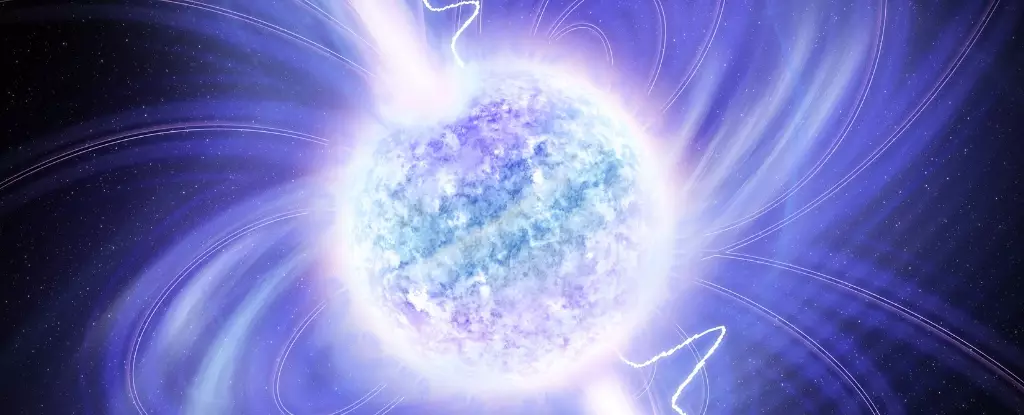In the heart of our universe, pulsars have long captivated astronomers with their captivating behavior. These celestial bodies emit beams of radio waves as they rapidly rotate, creating a lighthouse effect that allows us to perceive them as they sweep around us. Typically, these astronomical marvels complete a rotation within seconds, or even milliseconds, leading to a robust classification known as “pulsars.” However, the unfolding narrative surrounding pulsars is evolving. Recent investigations have brought to light an extraordinary cosmic object, ASKAP J1839-0756, pushing our comprehension of these celestial bodies into uncharted territories.
An examination of ASKAP J1839-0756 reveals a stark contrast to its rapid-spinning counterparts. Detected using the Australian Square Kilometre Array Pathfinder (ASKAP) telescope, this object exhibits a leisurely rotation period of 6.5 hours, a pace that defies the conventions of what we anticipate from neutron stars. Unlike many of its pulsating family members, which shine intermittently and fit neatly into existing theoretical frameworks, ASKAP J1839-0756 is elegantly challenging our understanding of stellar behavior in profound ways.
The discovery of ASKAP J1839-0756 was serendipitous. During a routine survey in the Wajarri Yamaji country of Western Australia, astronomers noticed an unusual radio emission that had not been documented before. Interestingly, its initial burst of radio waves showed a dramatic drop in brightness—by as much as 95%—within just 15 minutes. This unexpected behavior left researchers puzzled but intrigued, leading them to conduct further telescopic studies using other sensitive arrays such as the Australia Telescope Compact Array and the MeerKAT telescope in South Africa.
After additional scrutiny, researchers confirmed the periodic nature of the radio emissions from ASKAP J1839-0756. The discovery of two distinct pulses, spaced 6.5 hours apart, not only verified the object’s period but also raised numerous questions about its fundamental nature and origin. The enigma deepened as initial models of neutron star behavior could not adequately explain the existence of an object emitting radio waves at such a leisurely pace.
Astronomical theories have long posited that neutron stars, by their very nature, should cease to emit radio waves once their rotation decelerates past a critical threshold, typically around one rotation per minute. The detection of ASKAP J1839-0756, spinning at 6.5 hours—a stunning 390 times slower than this theoretical limit—compels scientists to reconsider what is permissible within neutron star dynamics.
Moreover, the peculiar characteristics of ASKAP J1839-0756 do not end with its slow rotation. It appears that we are witnessing emissions from both of its magnetic poles, a rare occurrence among pulsars. Most pulsars engage in a one-sided display of their emissions due to the alignment of their rotation and magnetic axes. However, the unique axis arrangement of ASKAP J1839-0756 allows for dual emissions, a phenomenon known as “interpulses.” The first pulse, observed as the main emission, is followed roughly 3.2 hours later by a weaker pulse that may derive from the object’s opposite magnetic pole.
This dual-pulse behavior gives scientists crucial insights into the symmetry—and potential misalignment—between a pulsar’s rotational speed and magnetic field alignment. The characteristics of these interpulses could aid in answering fundamental questions about spinning objects throughout the universe.
As researchers delve deeper into the peculiar features of ASKAP J1839-0756, they are faced with the challenge of classification. While one hypothesis suggests it may be a magnetar, notable for its intense magnetic field, magnetars typically exhibit periods in the seconds range rather than hours. Additionally, they often lack the radio emissions evident in ASKAP J1839-0756. Another consideration is the possibility of a white dwarf, the remnants of less massive stars, although no isolated white dwarfs have been recorded to emit radio pulses.
Despite these challenges, the discovery of ASKAP J1839-0756 undeniably signifies the limitations of our existing models and our grasp of cosmic behavior. Such unprecedented findings enforce the idea that the universe is inherently unpredictable, continually challenging our perceptions and assumptions.
As astronomers continue to scrutinize ASKAP J1839-0756, a broader narrative unfolds: one that underscores the dynamic and mysterious nature of the cosmos. This captivating object serves not only as an anomaly but also as a catalyst for future research and exploration. In our quest to comprehend the universe, ASKAP J1839-0756 exemplifies the wondrous surprises that lie just beyond our current understanding, beckoning us to venture deeper into astral enigmas yet to be unraveled.

